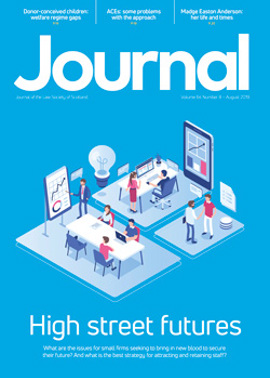ACEs high, or low?

In the last five years, there has been much said and written in relation to adverse childhood experiences (ACEs). The Scottish Government, in its programme Delivering for Today, Investing for Tomorrow: Government’s programme for Scotland 2018-2019, made a commitment to preventing ACEs and helping to reduce the negative impacts of ACEs when they occur, and to supporting the resilience of children and adults in overcoming adversity. Many public and third sector bodies also adopt an “ACEs-aware” status. However, we question whether the ACEs-aware approach is a robust and appropriate method of identifying past traumatic events and the impact of referrals to recovery services.
ACEs checklist
In practice, it is understood that when individuals answer ACEs questions, the participants must rely on the recollection of their childhood experiences, which they may not want to do, consciously or subconsciously. There may be very good psychological reasons why one might not want to or have the ability to recall a traumatic event.
The ACEs questions are imprecise, as they do not consider the severity, timing or duration of recalled physical, verbal or sexual abuse; nor the physical and emotional effects, in the aftermath of the disclosure of the event.
Divorce or separation in the family is listed as one of the questions on the ACEs checklist; however, it is accepted that not all breakdowns in relationships are harmful to the adults or children. Similarly, creating new relationships in a family can be a hugely positive experience for those involved.
Therefore for individuals, the effects of an ACE will be different on a case-by-case basis. Having one ACE may have a longer lasting and more harmful emotional effect than having had three or four other ACEs. We therefore suggest that caution should be exercised when using ACEs checklists to ensure that practitioners do not focus on the numbers alone.
What an ACEs approach does achieve is that it raises awareness of the potential negative effects that a persistent state of anxiety can have on a child’s brain development, which is referred to as “toxic stress”. According to the ACEs study from 1998 (Felliti et al), children who end up doing well despite the presence of persistent “toxic stress” are often the children who have built resilience having had at least one stable committed relationship and attachment with a supportive adult (parent, caregiver or other adult). This resilience buffers them from disruption in their brain development and enables children to develop skills such as the ability to plan, monitor and regulate behaviours and adapt to changing circumstances.
In practice, therefore, it is important to remember that if a child has been removed from their home, after having been exposed to such stresses or ACEs, but they also have had a protective relationship, it is essential that protective relationship continues, whether it was with a blood relative or not. If that relationship no longer exists, we must question, what are we replacing it with?
Also, what may cause anxiety to a child varies from child to child. For example, having social work involvement is usually seen as a positive intervention intended to improve a child’s welfare, but it may also contribute to the general feeling of anxiety and nervousness constituting an ACE in itself. Similarly, being exposed to state decision-making processes, including involvement in the children’s hearing system or court proceedings, may have a negative effect on a child, especially where the decision-making is delayed for procedural reasons.
Wider perspectives
ACEs questionnaires do not include a number of social issues such as being exposed to community violence; instances of terrorism or conflict; sectarian or gender-based violence; discrimination; and hate crime. In 2017, Women’s Aid reported that young people from the LGBTI community can face additional adverse experiences such as fear of being “outed”, fear of homophobia, biphobia and transphobia, which have a significant impact on them (Speaking out: Recalling Women’s Aid in Scotland: 40 years of Women’s Aid in Scotland (2017), and Safe Lives blog, “LGBT young people’s experiences of domestic abuse” February 2017).
We consider that the most significant omission from the checklist is the impact of poverty. It is greatly accepted that ACEs can occur across the wide socio-economic landscape. However, a family experiencing poverty may be at greater risk of adversity due to the lack of resources and access to support mechanisms to recover from its effects. Alleviating the elements of poverty will not in itself be sufficient to prevent or aid recovery from ACEs. Individuals and families experiencing poverty will require varying measures and supports from multiple services such as health, housing, financial, and family and trauma recovery services.
There is no magic bullet intervention or approach for complex social problems. Ideally, we would like to see targeted help offered to those who need it to reduce the levels of risk across the whole population. However, this may not be possible given the limited nature of public resource. In our view, it is crucial that a rights-based approach is taken to allocation of public resources, with clear vision and purpose as to how the use of that resource will meet the needs of the most vulnerable.
Focusing narrowly on selected ACEs criteria may limit the ability of professionals to identify and respond to the needs of individual children, and as a result can lead to mis-application of already limited public resources.
The General Teaching Council for Scotland reported that teachers and schools can change their perspective by changing the language they use in describing children’s behaviours (www.gtcs.org.uk/News/Blog/adverse-childhood-experiences.aspx). One Fife primary school altered its language from “challenging behaviour” to “distressed behaviour”. This changed the staff’s outlook on managing and supporting pupils by moving the conversation from behaviours to the causes of the behaviours. This change in language could go some way to changing views on how we support vulnerable children.
Recovery from trauma
It is accepted that even with the best efforts and best use of public resources, it will not be possible to prevent all instances of harm or adversity.
Articles 27 and 39 of the United Nations Convention on the Rights of the Child (UNCRC) recognise every child’s rights to enjoy the highest attainable standard of living, adequate for the child’s physical and mental health and development. States must take all appropriate measures to promote a child’s recovery if they have experienced neglect, abuse and trauma.
However, through the operation of the Scottish Child Law Centre’s national advice line, we have noted that children, young people and their families often have difficulties accessing mental health and additional support timeously from local public services.
What we often hear is that some services are not available locally at all, due to a shortage of staff and resources at the local government level, and if such services are available there is usually a lengthy waiting list. This can mean that a child’s condition deteriorates, requiring more intensive services for longer periods of time, making it increasingly difficult to recover from trauma.
What we must also highlight is that the speed of the referral and the availability of support and recovery services vary according to the geographical location of a child, i.e. creating a postcode lottery for children in Scotland.
We believe that one of the main priorities in accessing children’s health services should be increased availability and accessibility of a variety of health services for children and young people, particularly for those who are at increased risk or have experienced adversity or trauma in their lives. This includes children who are looked after, who have additional support for learning needs, or who are affected by disability or poverty. This might include local counselling, support groups, learning and development skills classes, respite services, play therapy, etc. This position is echoed in the Scottish Human Rights Commission’s submission to the Committee Against Torture, in March 2019: “adequate funding is… required to ensure that women and children receive support to access the services they require” (Periodic Review of the United Kingdom of Great Britain and Northern Ireland on Compliance on the UN Convention Against Torture and other Cruel, Inhuman, or Degrading Treatment or Punishment (UNCAT), p 9).
“ACEs-aware”
It is positive that professionals working with children and adults in difficult situations exercise understanding and patience, but on its own merely being “ACE-aware” could be relatively useless. After an individual completes the ACEs checklist, what then? What happens with their score data? If someone has a higher score than someone else, does this mean that they should receive a higher level of input or services?
ACEs tools are negative and request the participant to recall some of the most distressing events of their childhood. Assessing someone as having high level of ACEs and leaving them with no reassurance or explanation that they could have a high ACEs score and still be fine, particularly if they are not offered follow-up support, could be distressing and harmful in itself.
Being ACEs-aware implies being aware of the limited set of circumstances and experiences that may have an effect on the health, development and behaviour of the person. Being trauma-aware implies being aware to a wide range of factors which contribute to a person’s life experiences.
We urge those working with children and adults who have experienced trauma to remember that being ACEs or trauma-aware is only one element that they need to consider when working to improve the lives of children in Scotland, and that children have a right to recover from the events affecting them negatively and receive appropriate support timeously; access to services should not be linked to a list of particular events and should be provided according to the needs of the child.
In conclusion, we would like to emphasise the importance of restraint in relying too heavily on predicting the future. An ACEs approach should not be used as a predictive model.
One must be careful not to stigmatise children, nor define them on the basis of any adverse childhood events and experiences. Rather, we suggest that children ought to be respected as individuals with unlimited potential to become whoever they want to become, because the adults around them believe in their rights to receive the necessary supports and assistance to build resilience and recover from whatever ACE or traumatic event they have had in their childhood.
Regulars
Features
Briefings
In practice
In this issue
- The Judicial Disappointments Board
- Hiding in plain sight
- Food for thought on the drug front
- Salmon farming law must change
- People on the move - Aug 19
- Managing compliance to drive legal practice success
- New practice area: financial services – asset management
- Resilience: your flexible friend
- Appreciation: William Denys Cathcart Andrews






